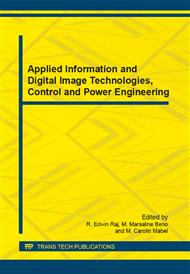[1]
J. Rodriguez, J. S. Lai, and F. Z. Peng, Multilevel inverters: A survey of topologies, controls, and applications, IEEE Trans. Ind. Electron., vol. 49, no. 4, p.724–738, Aug. (2002).
DOI: 10.1109/tie.2002.801052
Google Scholar
[2]
J. Rodriguez, L. G. Franquelo, S. Kouro, J. I. Leon, R. C. Portillo, M. A.M. Prats, and M.A. Perez, Multilevel converters: An enabling technology for high-power applications, Proc. IEEE, vol. 97, no. 11, p.1786–1817, Nov. (2009).
DOI: 10.1109/jproc.2009.2030235
Google Scholar
[3]
D. Krug, S. Bernet, S. S. Fazel, K. Jalili, and M. Malinowski, Comparisonof 2. 3-kV medium-voltage multilevel converters for industrialmedium-voltage drives, IEEE Trans. Ind. Electron., vol. 54, no. 6, p.2979–2992, Dec. (2007).
DOI: 10.1109/tie.2007.906997
Google Scholar
[4]
J. S. Lai, and F. Z. Peng, Multilevel converters-A new breed of power converters, IEEE Trans. on Ind. Appl., vol. 32, pp.509-517, (1996).
DOI: 10.1109/28.502161
Google Scholar
[5]
L. M. Tolbert, F. Z. Peng, and T. G. Habetler, Multilevel converters for large electric drives, IEEE Trans. on Ind. Appl., vol. 35, pp.36-44, (1999).
DOI: 10.1109/28.740843
Google Scholar
[6]
S. Jeevananthan, Evolutionary Computing Based Area Integration PWM Technique for Multilevel Inverters, Journal of Electrical Systems, vol. 3, no. 2, pp.61-72 June (2007).
DOI: 10.1109/iicpe.2006.4685342
Google Scholar
[7]
S. Ramkumar, S. Jeevananthan and V. Kamaraj, Novel Amplitude Modulated Triangular Carrier Gain Linearization Technique for SPWM Inverter, Serbian Journal of Electrical Engineering (SJEE), vol. 6, no. 2, pp.239-252, November, (2009).
DOI: 10.2298/sjee0902239r
Google Scholar
[8]
S. Ramkumar, V. Kamaraj, S. Thamizharasan, S. Jeevananthan, A New Series Parallel Switched Multilevel DC-Link Inverter Topology, International Journal of Electrical Power and Energy Systems (Elsevier), vol. 36, no. 1, pp.93-99, (2012).
DOI: 10.1016/j.ijepes.2011.10.028
Google Scholar
[9]
Brendan Peter McGrath, and Donald Grahame Holmes, Multicarrier PWM Strategies for Multilevel Inverters, IEEE Transactions on Industrial Electronics, vol. 49, no. 4, pp.858-867, August (2002).
DOI: 10.1109/tie.2002.801073
Google Scholar
[10]
Tolbert, L.M. and Habetler, T.G., Novel multilevel inverter carrier-based PWM method, IEEE Transactions Industrial Applications, September/October, vol. 35, no. 5, (1999).
DOI: 10.1109/28.793371
Google Scholar
[11]
S. Jeevananthan, S. Paramasivam and S. Thamizharasan, A novel invariable carrier frequency multi-level inverter PWM for balancing switching transitions and better distribution of harmonic power, International Journal on Power Electronics, vol. 4, no. 3, (2012).
DOI: 10.1504/ijpelec.2012.046601
Google Scholar
[12]
PhoivosD. Ziogas, The delta modulation technique in static PWM inverters, IEEE Transactions on Industry Application, vol. 1A-17, pp.199-203, March/April (1981).
DOI: 10.1109/tia.1981.4503925
Google Scholar
[13]
J.A. Houldsworth and D.A. Grant, The Use Harmonic Distortion to Increase the Output Voltage of Three-Phase PWM Inverter, IEEE Transaction on Industry Application, vol. 1 IA-20, pp.1224-1228, Sept/Oct (1984).
DOI: 10.1109/tia.1984.4504587
Google Scholar
[14]
K. Taniguchi, Y. ogino and H. Irie, PWM technique for power MOSFET inverter, IEEE Transactions on Power Electronics, vol. 3, no. 2, p. pp.328-334, July (1988).
DOI: 10.1109/63.17951
Google Scholar
[15]
Kazmierkowski, M.P., Krishnan, R. and Blaabjerg, F., Control in Power Electronics- Selected Problems, Academic Press London, 2002, New york.
Google Scholar
[16]
Hava A. M, R. Kerkman and T.A. Lipo, A High-Performance Generalized Discontinuous PWM Algorithm, IEEE Transactions on Industry Applications, vol. 34, no. 5, pp. no. 1059-1071, (1998).
DOI: 10.1109/28.720446
Google Scholar
[17]
S. Jeevananthan, P. Dananjayan and S. Venkatesan, A Novel Modified Carrier PWM Switching Strategy for Single-Phase Full-Bridge Inverter, Iranian Journal of Electrical and Computer Engineering, vol. 4, no. 2, (2005).
Google Scholar
[18]
S. Jeevananthan, R. Nandhakumar and P. Dananjayan, Inverted Sine Carrier for Fundamental Fortification in PWM Inverters and FPGA Based Implementations, Serbian Journal of Electrical Engineering, vol. 4, no. 2, November (2007).
DOI: 10.2298/sjee0702171j
Google Scholar


